Study on the Influence of Topography on Dew Amount—A Case Study of Hilly and Gully Regions in the Loess Plateau, China
Abstract
1. Introduction
2. Materials and Methods
2.1. Experimental Site
2.2. Experimental Design
2.3. Data Processing
2.3.1. LWS Calibration
2.3.2. Dew Point Temperature Calculation
2.3.3. Wind Speed Conversion Calculation
2.3.4. Definitions
3. Results
3.1. Daily Variation in Dew
3.2. Monthly Variation in Dew
3.3. Influence Factors
3.3.1. Relative Humidity
3.3.2. The Difference Between Air Temperature and Dewpoint Temperature
3.3.3. Wind Speed and Direction
3.3.4. Rainfall
4. Discussion
4.1. Dew Characteristics
4.2. Driving Factors of Dew Formation
4.3. Influence of Topography on Dew
4.4. Ecological Effects of Dew
5. Conclusions
Author Contributions
Funding
Institutional Review Board Statement
Informed Consent Statement
Data Availability Statement
Acknowledgments
Conflicts of Interest
References
- Muselli, M.; Lekouch, I.; Beysens, D. Physical and Chemical Characteristics of Dew and Rain in North-West Africa with Focus on Morocco: Mapping Past and Future Evolution (2005–2100). Atmosphere 2022, 13, 1974. [Google Scholar] [CrossRef]
- Zhang, Q.; Wang, S.; Yang, F.-L.; Yue, P.; Yao, T.; Wang, W.Y. Characteristics of Dew Formation and Distribution, and Its Contribution to the Surface Water Budget in a Semi-arid Region in China. Bound. Layer Meteorol. 2015, 154, 317–331. [Google Scholar] [CrossRef]
- Tomaszkiewicz, M.; Najm, M.A.; Zurayk, R.; El-Fadel, M. Dew as an adaptation measure to meet water demand in agriculture and reforestation. Agric. For. Meteorol. 2017, 232, 411–421. [Google Scholar] [CrossRef]
- Wang, L.N.; Zhu, Q.K.; Zhao, W.J.; Zhao, X.K. The drought trend and its relationship with rainfall intensity in the Loess Plateau of China. Nat. Hazards 2015, 77, 479–495. [Google Scholar] [CrossRef]
- Meng, Y.; Wen, X. Characteristics of dew events in an arid artificial oasis cropland and a sub-humid cropland in China. J. Arid Land 2016, 8, 399–408. [Google Scholar] [CrossRef]
- Agam, N.; Berliner, P.R. Dew formation and water vapor adsorption in semi-arid environments—A review. J. Arid Environ. 2006, 65, 572–590. [Google Scholar] [CrossRef]
- Wang, X.; Gao, Z.Y.; Wang, Y.K.; Wang, Z.; Jin, S.S. Dew measurement and estimation of rain-fed jujube (Zizyphus jujube Mill) in a semi-arid loess hilly region of China. J. Arid Land 2017, 9, 547–557. [Google Scholar] [CrossRef]
- Feng, T.; Zhang, L.; Chen, Q.; Ma, Z.; Wang, H.; Shangguan, Z.; Wang, L.; He, J.-S. Dew formation reduction in global warming experiments and the potential consequences. J. Hydrol. 2021, 593, 125819. [Google Scholar] [CrossRef]
- Jorgenson, M.T.; Racine, C.H.; Walters, J.C.; Osterkamp, T.E. Permafrost Degradation and Ecological Changes Associated with a Warming Climate in Central Alaska. Clim. Chang. 2001, 48, 551–579. [Google Scholar] [CrossRef]
- McGuire, A.D.; Wirth, C.; Apps, M.; Beringer, J.; Clein, J.; Epstein, H.; Kicklighter, D.W.; Bhatti, J.; Chapin, F.S.; de Groot, B.; et al. Environmental variation, vegetation distribution, carbon dynamics and water/energy exchange at high latitudes. J. Veg. Sci. 2002, 13, 301–314. [Google Scholar] [CrossRef]
- Ucles, O.; Villagarcia, L.; Canton, Y.; Domingo, F. Microlysimeter station for long term non-rainfall water input and evaporation studies. Agric. For. Meteorol. 2013, 182, 13–20. [Google Scholar] [CrossRef]
- Kidron, G.J.; Temina, M. Non-rainfall water input determines lichen and cyanobacteria zonation on limestone bedrock in the Negev Highlands. Flora 2017, 229, 71–79. [Google Scholar] [CrossRef]
- Kaseke, K.F.; Wang, L. Fog and Dew as Potable Water Resources: Maximizing Harvesting Potential and Water Quality Concerns. Geohealth 2018, 2, 327–332. [Google Scholar] [CrossRef]
- Westra, S.; Fowler, H.J.; Evans, J.P.; Alexander, L.V.; Berg, P.; Johnson, F.; Kendon, E.J.; Lenderink, G.; Roberts, N.M. Future changes to the intensity and frequency of short-duration extreme rainfall. Rev. Geophys. 2014, 52, 522–555. [Google Scholar] [CrossRef]
- Koutsoyiannis, D. Revisiting the global hydrological cycle: Is it intensifying? Hydrol. Earth Syst. Sci. 2020, 24, 3899–3932. [Google Scholar] [CrossRef]
- Pumo, D.; Noto, L.V. Exploring the linkage between dew point temperature and precipitation extremes: A multi-time-scale analysis on a semi-arid Mediterranean region. Atmos. Res. 2021, 254, 105508. [Google Scholar] [CrossRef]
- Zheng, Y.; Bai, H.; Huang, Z.; Tian, X.; Nie, F.-Q.; Zhao, Y.; Zhai, J.; Jiang, L. Directional water collection on wetted spider silk. Nature 2010, 463, 640–643. [Google Scholar] [CrossRef] [PubMed]
- Pan, Z.; Pitt, W.G.; Zhang, Y.; Wu, N.; Tao, Y.; Truscott, T.T. The upside-down water collection system of Syntrichia caninervis. Nat. Plants 2016, 2, 16076. [Google Scholar] [CrossRef]
- Tuure, J.; Korpela, A.; Hautala, M.; Rautkoski, H.; Hakojärvi, M.; Mikkola, H.; Duplissy, J.; Pellikka, P.; Petäjä, T.; Kulmala, M.; et al. Comparing plastic foils for dew collection: Preparatory laboratory-scale method and field experiment in Kenya. Biosyst. Eng. 2020, 196, 145–158. [Google Scholar] [CrossRef]
- Kool, D.; Agra, E.; Drabkin, A.; Duncan, A.; Fendinat, P.P.; Leduc, S.; Lupovitch, G.; Nambwandja, A.N.; Ndilenga, N.S.; Nguyễn Thị, T.; et al. The overlooked non-rainfall water input sibling of fog and dew: Daily water vapor adsorption on a !Nara hummock in the Namib Sand Sea. J. Hydrol. 2021, 598, 126420. [Google Scholar] [CrossRef]
- Gerlein-Safdi, C.; Koohafkan, M.C.; Chung, M.; Rockwell, F.E.; Thompson, S.; Caylor, K.K. Dew deposition suppresses transpiration and carbon uptake in leaves. Agric. For. Meteorol. 2018, 259, 305–316. [Google Scholar] [CrossRef]
- Riedl, A.; Li, Y.; Eugster, J.; Buchmann, N.; Eugster, W. Technical note: High-accuracy weighing micro-lysimeter system for long-term measurements of non-rainfall water inputs to grasslands. Hydrol. Earth Syst. Sci. 2022, 26, 91–116. [Google Scholar] [CrossRef]
- Juřička, D.; Pecina, V.; Kusbach, A.; Vlček, V.; Novotná, J.; Pařílková, J.; Otgonsuren, B.; Brtnický, M.; Kynický, J. Thermal regime of semi-natural dew collector’s perspective for afforestation of semi-arid landscapes. Environ. Technol. Innov. 2020, 20, 101125. [Google Scholar] [CrossRef]
- Scherm, H.; Bruggen, A.H.C.v. Sensitivity of simulated dew duration to meteorological variations in different climatic regions of California. Agric. For. Meteorol. 1993, 66, 229–245. [Google Scholar] [CrossRef]
- Hao, X.; Li, C.; Guo, B.; Ma, J.X.; Ayup, M.; Chen, Z.S. Dew formation and its long-term trend in a desert riparian forest ecosystem on the eastern edge of the Taklimakan Desert in China. J. Hydrol. 2012, 472–473, 90–98. [Google Scholar] [CrossRef]
- Zhuang, Y.; Zhao, W.; Luo, L.; Wang, L. Dew formation characteristics in the gravel desert ecosystem and its ecological roles on Reaumuria soongorica. J. Hydrol. 2021, 603, 126932. [Google Scholar] [CrossRef]
- Beysens, D. Estimating dew yield worldwide from a few meteo data. Atmos. Res. 2016, 167, 146–155. [Google Scholar] [CrossRef]
- Kaseke, K.F.; Wang, L.X.; Seely, M.K. Nonrainfall water origins and formation mechanisms. Sci. Adv. 2017, 3, e1603131. [Google Scholar] [CrossRef] [PubMed]
- Kidron, G.J. Analysis of dew precipitation in three habitats within a small arid drainage basin, Negev Highlands, Israel. Atmos. Res. 2000, 55, 257–270. [Google Scholar] [CrossRef]
- Kidron, G.J. The effect of substrate properties, size, position, sheltering and shading on dew: An experimental approach in the Negev Desert. Atmos. Res. 2010, 98, 378–386. [Google Scholar] [CrossRef]
- Kidron, G.J.; Temina, M.; Starinsky, A. An Investigation of the Role of Water (Rain and Dew) in Controlling the Growth Form of Lichens on Cobbles in the Negev Desert. Geomicrobiol. J. 2011, 28, 335–346. [Google Scholar] [CrossRef]
- Kidron, G.J.; Starinsky, A.; Yaalon, D.H. Cyanobacteria are confined to dewless habitats within a dew desert: Implications for past and future climate change for lithic microorganisms. J. Hydrol. 2014, 519, 3606–3614. [Google Scholar] [CrossRef]
- Yu, R.; Zhang, Z.; Lu, X.; Chang, I.S.; Liu, T. Variations in dew moisture regimes in desert ecosystems and their influencing factors. Wiley Interdiscip. Rev. Water 2020, 7, e1482. [Google Scholar] [CrossRef]
- Zhuang, Y.; Zhao, W. Dew variability in three habitats of a sand dune transect in a desert oasis ecotone, Northwestern China. Hydrol. Process. 2014, 28, 1399–1408. [Google Scholar] [CrossRef]
- Groh, J.; Slawitsch, V.; Herndl, M.; Graf, A.; Vereecken, H.; Pütz, T. Determining dew and hoar frost formation for a low mountain range and alpine grassland site by weighable lysimeter. J. Hydrol. 2018, 563, 372–381. [Google Scholar] [CrossRef]
- Li, M.; Yang, E.; Li, P.; Shen, Z.; Bao, H.; Ni, Y. Identifying sediment sources from the inter-gully area and gully area in a small watershed in the Loess Hilly Region of China. Environ. Earth Sci. 2017, 76, 776. [Google Scholar] [CrossRef]
- Li, C.; Li, F.; Dai, Z.; Yang, X.; Cui, X.; Luo, L. Spatial variation of gully development in the loess plateau of China based on the morphological perspective. Earth Sci. Inform. 2020, 13, 1–15. [Google Scholar] [CrossRef]
- Xiao, B.; Ma, S.; Hu, K. Moss biocrusts regulate surface soil thermal properties and generate buffering effects on soil temperature dynamics in dryland ecosystem. Geoderma 2019, 351, 9–24. [Google Scholar] [CrossRef]
- Gao, L.; Bowker, M.A.; Xu, M.; Sun, H.; Tuo, D.; Zhao, Y. Biological soil crusts decrease erodibility by modifying inherent soil properties on the Loess Plateau, China. Soil Biol. Biochem. 2017, 105, 49–58. [Google Scholar] [CrossRef]
- Wang, L.; Kaseke, K.F.; Seely, M.K. Effects of non-rainfall water inputs on ecosystem functions. Wiley Interdiscip. Rev. Water 2017, 4, 1179. [Google Scholar] [CrossRef]
- Zhuang, Y.; Ratcliffe, S. Relationship between dew presence and Bassia dasyphylla plant growth. J. Arid Land 2012, 4, 11–18. [Google Scholar] [CrossRef][Green Version]
- Zhuang, Y.; Zhao, W. Dew formation and its variation in Haloxylon ammodendron plantations at the edge of a desert oasis, northwestern China. Agric. For. Meteorol. 2017, 247, 541–550. [Google Scholar] [CrossRef]
- Jia, Z.; Wu, B.; Wei, W.; Chang, Y.; Lei, R.; Hu, W.; Jiang, J. Effect of Plastic Membrane and Geotextile Cloth Mulching on Soil Moisture and Spring Maize Growth in the Loess–Hilly Region of Yan’an, China. Agronomy 2023, 13, 2513. [Google Scholar] [CrossRef]
- Zhao, D.; Xu, M.; Liu, G.; Yao, X.; Tuo, D.; Zhang, R.; Xiao, T.; Peng, G. Quantification of soil aggregate microstructure on abandoned cropland during vegetative succession using synchrotron radiation-based micro-computed tomography. Soil Tillage Res. 2017, 165, 239–246. [Google Scholar] [CrossRef]
- Xu, M.; Zhang, J.; Liu, G.B.; Yamanaka, N. Soil properties in natural grassland, Caragana korshinskii planted shrubland, and Robinia pseudoacacia planted forest in gullies on the hilly Loess Plateau, China. Catena 2014, 119, 116–124. [Google Scholar] [CrossRef]
- Li, M.; Zhang, X.; Pang, G.; Han, F. The estimation of soil organic carbon distribution and storage in a small catchment area of the Loess Plateau. Catena 2013, 101, 11–16. [Google Scholar] [CrossRef]
- Wang, Z.J.; Jiao, J.Y.; Rayburg, S.; Wang, Q.L.; Su, Y. Soil erosion resistance of “Grain for Green” vegetation types under extreme rainfall conditions on the Loess Plateau, China. Catena 2016, 141, 109–116. [Google Scholar] [CrossRef]
- Fang, X.; Zhao, W.; Wang, L.; Feng, Q.; Ding, J.; Liu, Y.; Zhang, X. Variations of deep soil moisture under different vegetation types and influencing factors in a watershed of the Loess Plateau, China. Hydrol. Earth Syst. Sci. 2016, 20, 3309–3323. [Google Scholar] [CrossRef]
- Kou, M.; Garcia-Fayos, P.; Hu, S.; Jiao, J. The effect of Robinia pseudoacacia afforestation on soil and vegetation properties in the Loess Plateau (China): A chronosequence approach. For. Ecol. Manag. 2016, 375, 146–158. [Google Scholar] [CrossRef]
- Wang, H.; Jia, Z.; Wang, Z. Dew amount and its inducing factors in the loess hilly region of northern Shaanxi Province, China. Chin. J. Appl. Ecol. 2017, 28, 3703–3710. [Google Scholar] [CrossRef]
- Jia, Z.; Wang, Z.; Wang, H. Characteristics of Dew Formation in the Semi-Arid Loess Plateau of Central Shaanxi Province, China. Water 2019, 11, 126. [Google Scholar] [CrossRef]
- Lawrence, M.G. The Relationship between Relative Humidity and the Dewpoint Temperature in Moist Air: A Simple Conversion and Applications. Bull. Am. Meteorol. Soc. 2005, 86, 225–234. [Google Scholar] [CrossRef]
- Alduchov, O.A.; Eskridge, R.E. Improved Magnus form approximation of saturation vapor pressure. J. Appl. Meteorol. 1996, 35, 601–609. [Google Scholar] [CrossRef]
- Sharan, G.; Beysens, D.; Milimouk-Melnytchouk, I. A study of dew water yields on Galvanized iron roofs in Kothara (North-West India). J. Arid Environ. 2007, 69, 259–269. [Google Scholar] [CrossRef]
- Feng, T.; Huang, F.; Zhu, S.; Bu, L.; Qi, Z.; Li, L. Dew amount and its long-term variation in the Kunes River Valley, Northwest China. J. Arid Land 2022, 14, 753–770. [Google Scholar] [CrossRef]
- Liu, M.; Cen, Y.; Wang, C.; Gu, X.; Bowler, P.; Wu, D.; Zhang, L.; Jiang, G.; Beysens, D. Foliar uptake of dew in the sandy ecosystem of the Mongolia Plateau: A life-sustaining and carbon accumulation strategy shared differently by C3 and C4 grasses. Agric. For. Meteorol. 2020, 287, 107941. [Google Scholar] [CrossRef]
- Guo, X.A.; Wang, Y.F.; Yan, H.M.; Liu, P.; Tian, Y.; Shang, G.F.; Jin, C.; Zha, T.S. Dew/hoar frost on the canopies and underlying surfaces of two typical desert shrubs in Northwest China and their relevance to drought. J. Hydrol. 2022, 609, 12. [Google Scholar] [CrossRef]
- Tomaszkiewicz, M.; Abou Najm, M.; Beysens, D.; Alameddine, I.; Bou Zeid, E.; El-Fadel, M. Projected climate change impacts upon dew yield in the Mediterranean basin. Sci. Total Environ. 2016, 566–567, 1339–1348. [Google Scholar] [CrossRef]
- Li, S.L.; Bowker, M.A.; Xiao, B. Biocrusts enhance non-rainfall water deposition and alter its distribution in dryland soils. J. Hydrol. 2021, 595, 126050. [Google Scholar] [CrossRef]
- Wang, X.P.; Pan, Y.X.; Hu, R.; Zhang, Y.F.; Zhang, H. Condensation of water vapour on moss-dominated biological soil crust, NW China. J. Earth Syst. Sci. 2014, 123, 297–305. [Google Scholar] [CrossRef]
- Guo, X.; Zha, T.; Jia, X.; Wu, B.; Feng, W.; Xie, J.; Gong, J.; Zhang, Y.; Peltola, H. Dynamics of Dew in a Cold Desert-Shrub Ecosystem and Its Abiotic Controls. Atmosphere 2016, 7, 7030032. [Google Scholar] [CrossRef]
- Kabela, E.D. Dew frequency, duration, amount, and distribution in corn and soybean during SMEX05. Agric. For. Meteorol. 2009, 149, 11–24. [Google Scholar] [CrossRef]
- Muselli, M.; Beysens, D.; Marcillat, J.; Milimouk, I.; Nilsson, T.; Louche, A. Dew water collector for potable water in Ajaccio (Corsica Island, France). Atmos. Res. 2002, 64, 297–312. [Google Scholar] [CrossRef]
- Beysens, D.; Muselli, M.; Nikolayev, V.; Narhe, R.; Milimouk, I. Measurement and modelling of dew in island, coastal and alpine areas. Atmos. Res. 2004, 73, 1–22. [Google Scholar] [CrossRef]
- Fang, J. Variability in condensation water and its determinants in arid regions of north-western China. Ecohydrology 2020, 13, 2226. [Google Scholar] [CrossRef]
- Salau, O.A.; Lawson, T.L. Dewfall features of a tropical station: The case of Onne (Port Hartcourt), Nigeria. Theor. Appl. Climatol. 1986, 37, 233–240. [Google Scholar] [CrossRef]
- Uclés, O.; Villagarcía, L.; Cantón, Y.; Lázaro, R.; Domingo, F. Non-rainfall water inputs are controlled by aspect in a semiarid ecosystem. J. Arid Environ. 2015, 113, 43–50. [Google Scholar] [CrossRef]
- Shen, S.; Xiao, H.; Yang, H.; Fu, D.; Shu, W. Variations of water vapor transport and water vapor-hydrometeor-precipitation conversions during a heavy rainfall event in the Three-River-Headwater region of the Tibetan Plateau. Atmos. Res. 2021, 264, 105874. [Google Scholar] [CrossRef]
- Jia, R.L.; Li, X.R.; Liu, L.C.; Pan, Y.X.; Gao, Y.H.; Wei, Y.P. Effects of sand burial on dew deposition on moss soil crust in a revegetated area of the Tennger Desert, Northern China. J. Hydrol. 2014, 519, 2341–2349. [Google Scholar] [CrossRef]
- Dawson, T.E.; Goldsmith, G.R. The value of wet leaves. New Phytol. 2018, 219, 1156–1169. [Google Scholar] [CrossRef]
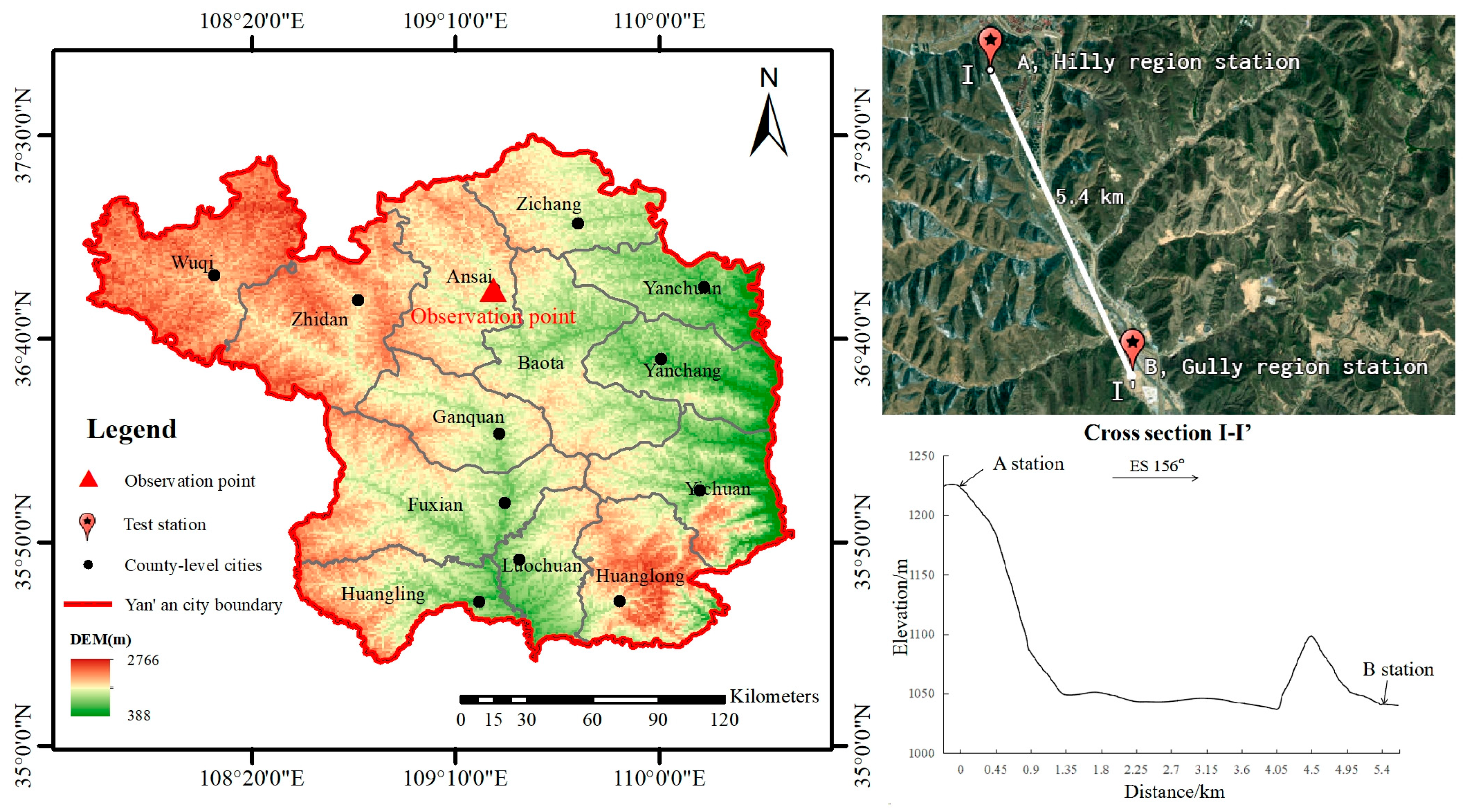
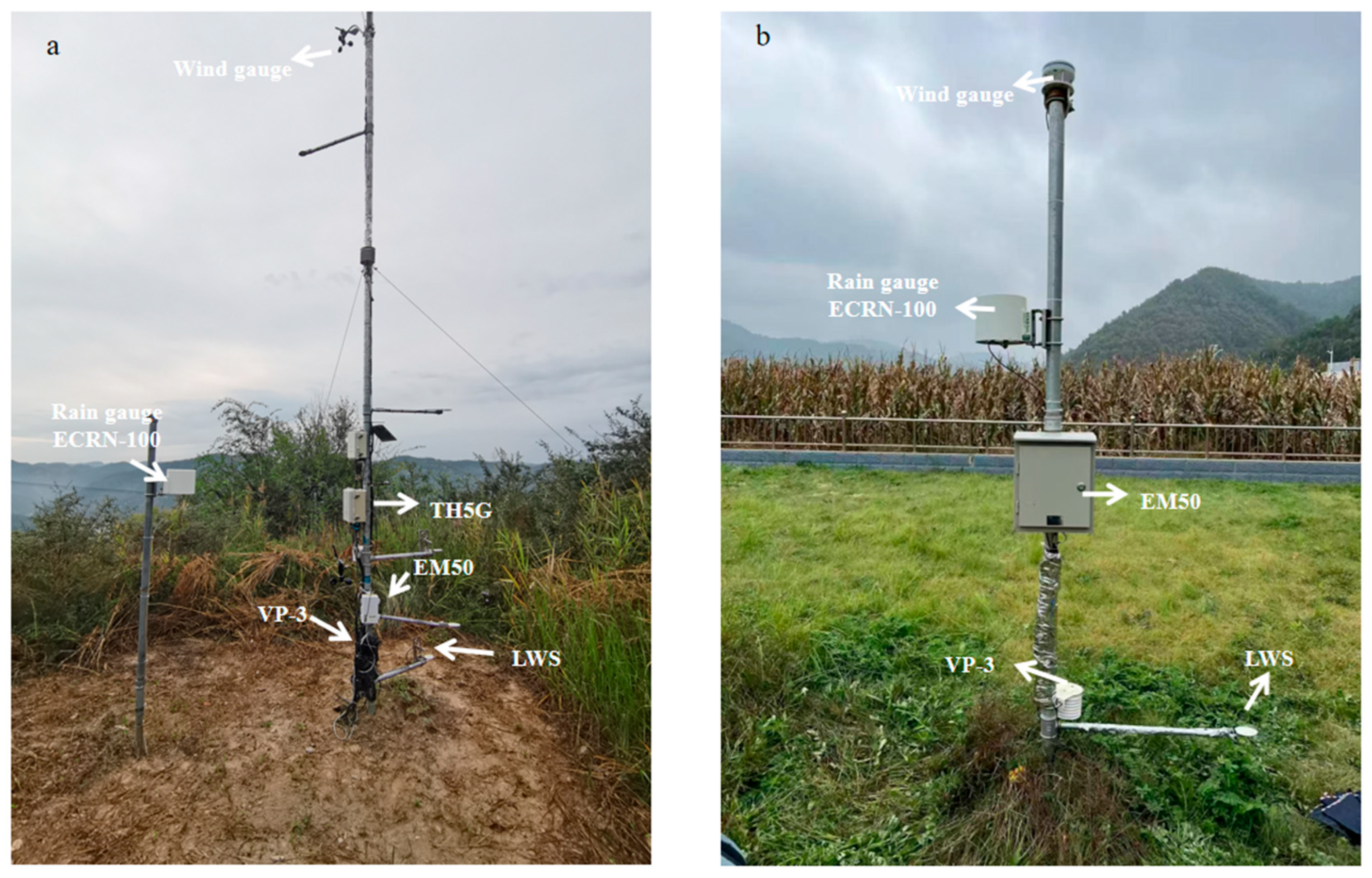


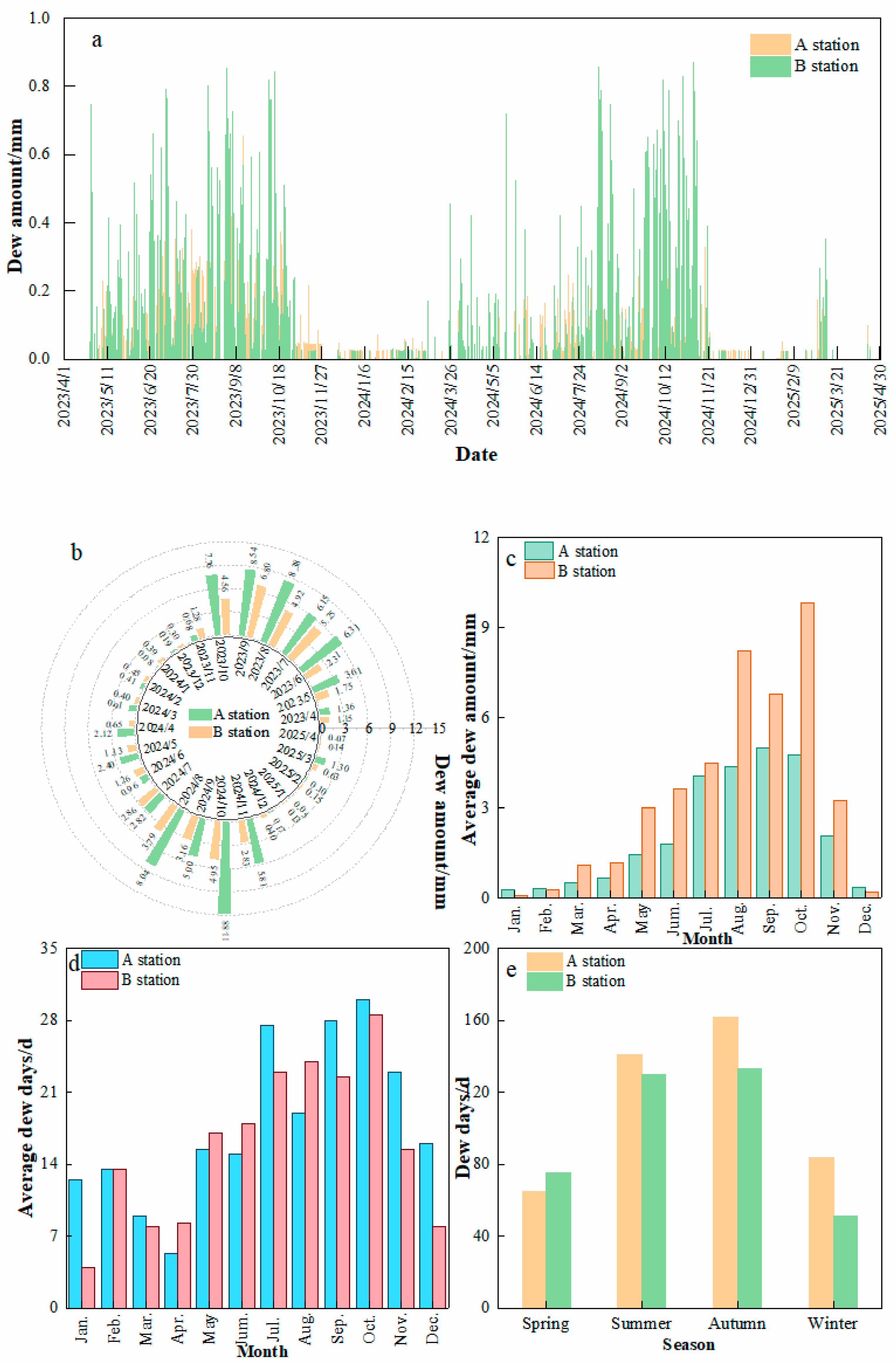
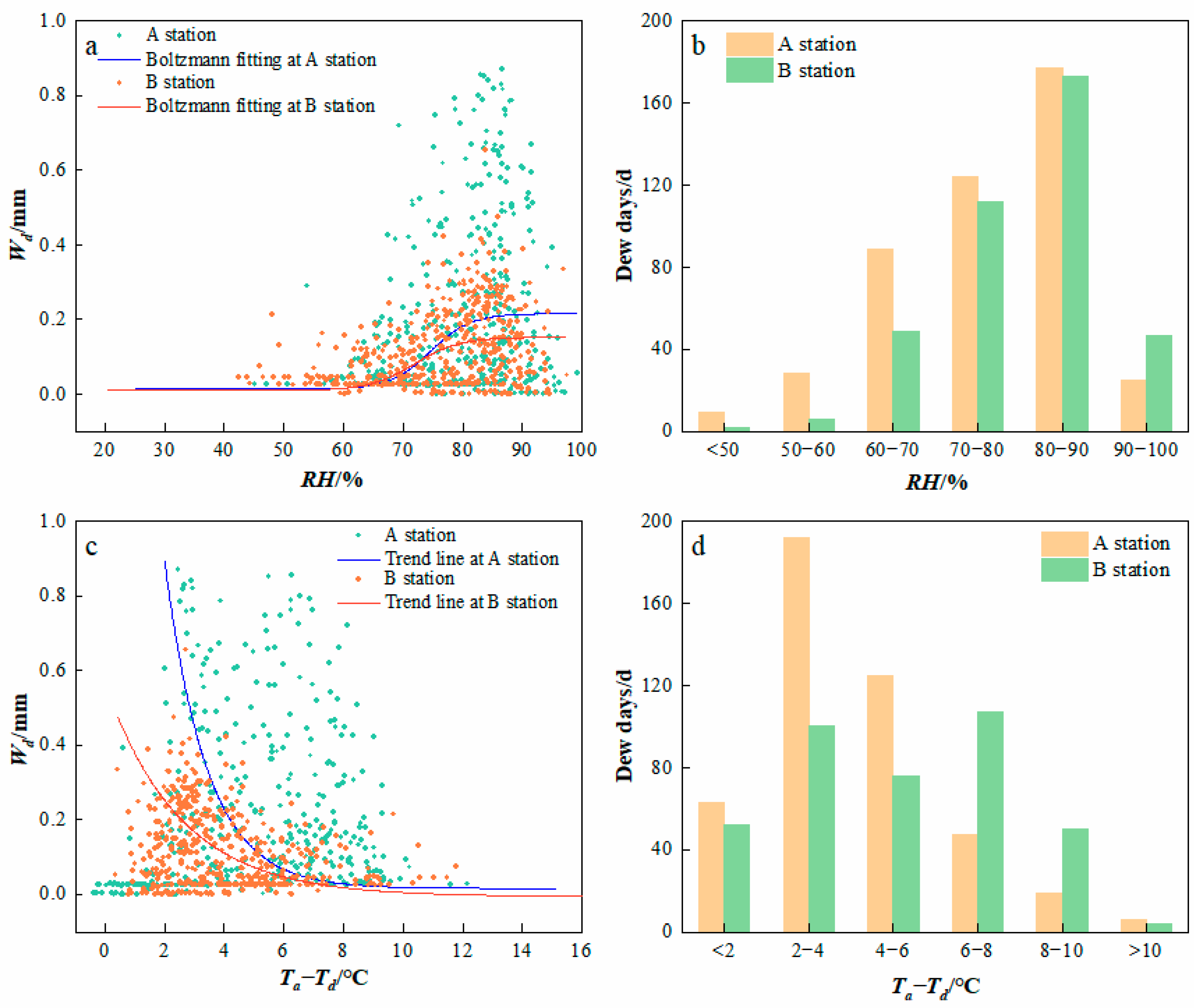

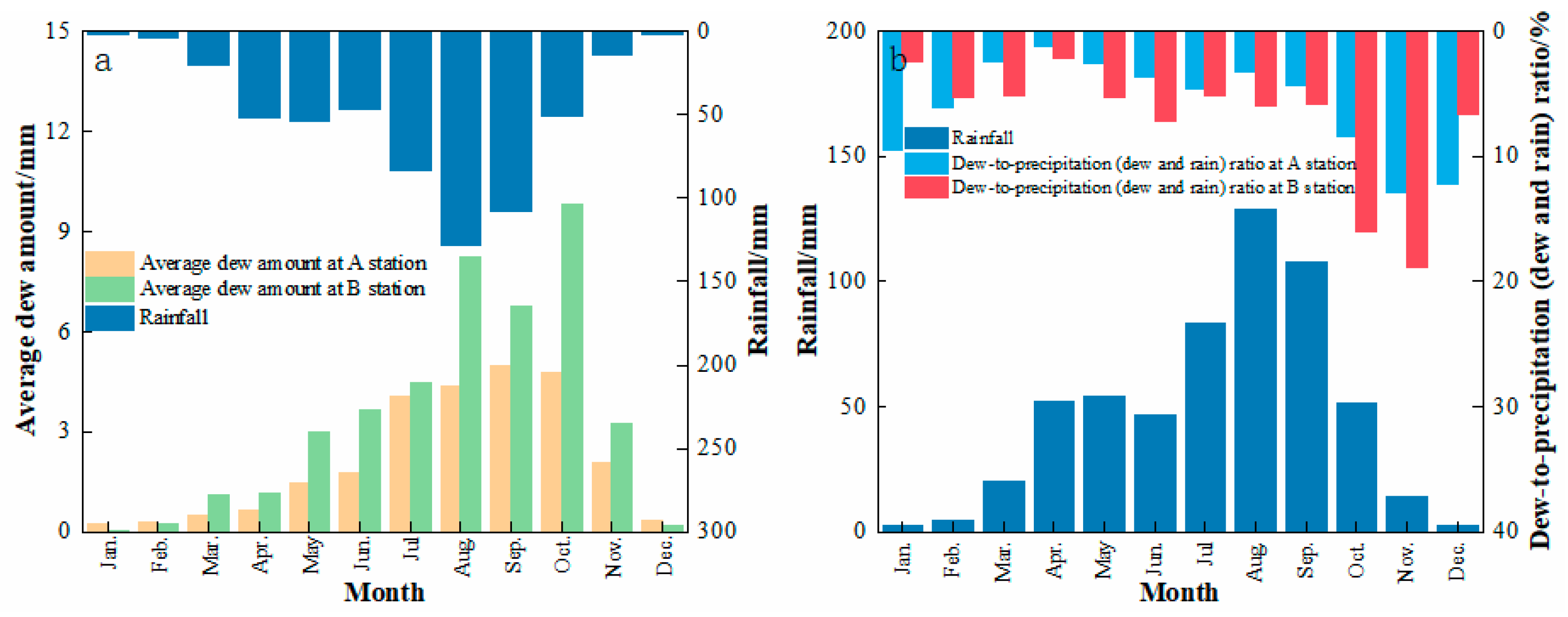

| Device | Installation Height | Parameter (Unit) | Accuracy |
|---|---|---|---|
| Anemoscope | 5 m (A station) 2 m (B station) | vs, m∙s−1 vd, ° | vs: ±0.45 m∙s−1 vd: ±1° |
| Hyetometer | 1.6 m | Rainfall, mm | ±0.2 mm |
| LWS | 0.2 m | U, mv; DT, min | U, ±1 mv; DT, ±1 min |
| VP-3 | 0.2 m | Ta °C; RH, % | T, ±0.2 °C; RH, ±0.1% |
Disclaimer/Publisher’s Note: The statements, opinions and data contained in all publications are solely those of the individual author(s) and contributor(s) and not of MDPI and/or the editor(s). MDPI and/or the editor(s) disclaim responsibility for any injury to people or property resulting from any ideas, methods, instructions or products referred to in the content. |
© 2025 by the authors. Licensee MDPI, Basel, Switzerland. This article is an open access article distributed under the terms and conditions of the Creative Commons Attribution (CC BY) license (https://creativecommons.org/licenses/by/4.0/).
Share and Cite
Jia, Z.; Liu, H.; Ma, Y. Study on the Influence of Topography on Dew Amount—A Case Study of Hilly and Gully Regions in the Loess Plateau, China. Atmosphere 2025, 16, 1098. https://doi.org/10.3390/atmos16091098
Jia Z, Liu H, Ma Y. Study on the Influence of Topography on Dew Amount—A Case Study of Hilly and Gully Regions in the Loess Plateau, China. Atmosphere. 2025; 16(9):1098. https://doi.org/10.3390/atmos16091098
Chicago/Turabian StyleJia, Zhifeng, Hao Liu, and Yan Ma. 2025. "Study on the Influence of Topography on Dew Amount—A Case Study of Hilly and Gully Regions in the Loess Plateau, China" Atmosphere 16, no. 9: 1098. https://doi.org/10.3390/atmos16091098
APA StyleJia, Z., Liu, H., & Ma, Y. (2025). Study on the Influence of Topography on Dew Amount—A Case Study of Hilly and Gully Regions in the Loess Plateau, China. Atmosphere, 16(9), 1098. https://doi.org/10.3390/atmos16091098








